Click on images to enlarge
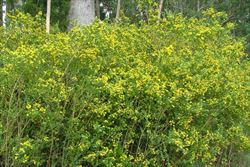
dense infestation (Photo: Sheldon Navie)
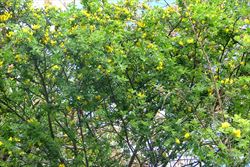
habit (Photo: Sheldon Navie)
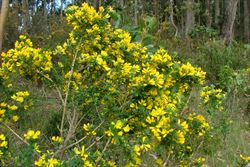
habit (Photo: Sheldon Navie)
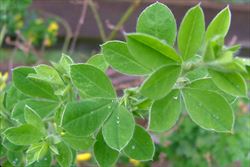
close-up of leaves with three relatively broad leaflets (Photo: Sheldon Navie)
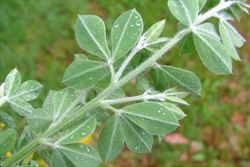
close-up of younger stems and hairy leaf undersides (Photo: Sheldon Navie)
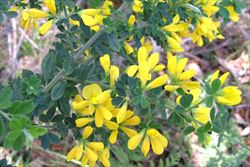
leaves and small flower clusters (Photo: Sheldon Navie)
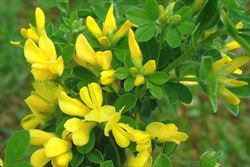
pea-shaped flowers (Photo: Sheldon Navie)
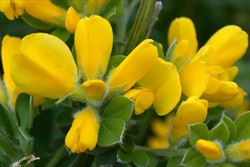
close-up of flowers (Photo: Rob and Fiona Richardson)

immature fruit (Photo: Rob and Fiona Richardson)
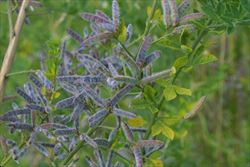
mature fruit (Photo: Trevor James)
Scientific Name
Genista monspessulana (L.) L.A.S. Johnson
Synonyms
Cytisus canariensis (L.)Kuntze (misapplied)Cytisus candicans (L.) DC.Cytisus monspessulanus L.Genista candicans L.Genista maderensis (Webb & Berth.) Lowe (misapplied)Teline monspessulana (L.) C. Koch
Family
Fabaceae (Queensland, the ACT, Victoria, Tasmania, and the Northern Territory)Fabaceae: sub-family Faboideae (New South Wales)Leguminosae (South Australia)Papilionaceae (Western Australia)
Common Names
broom, canary broom, Cape broom, common broom, French broom, Madeira broom, Montpellier broom, soft broom
Origin
Native to northern Africa (i.e. northern Algeria and Morocco), southern Europe (i.e. southern France, Portugal, Spain, Albania, Greece, Italy and Yugoslavia) and western Asia (i.e. western Turkey, Lebanon and Georgia).
Cultivation
Cape broom (Genista monspessulana) has was deliberately introduced into Australia and has been widely cultivated as a garden ornamental and hedging plant, particularly in temperate regions. Several horticultural hybrids involving this species are also commonly cultivated in Australia (e.g. Easter broom, Genista x spachiana).
Naturalised Distribution
A widely naturalised species that is mostly found in the temperate regions of southern Australia. It is most common and widespread in Victoria, Tasmania, the ACT, southern and central New South Wales, south-eastern South Australia and south-western Western Australia. Also naturalised in north-eastern New South Wales, in south-eastern Queensland, and on Norfolk Island.
Naturalised overseas in the UK, southern Africa (i.e. South Africa), New Zealand, western USA (i.e. California, Oregon and Washington), southern South America (i.e. Chile) and Hawaii.
Habitat
A weed of roadsides, railway lines, gardens, drains, fence lines, disturbed sites, waste areas, waterways, grasslands, open woodlands, forest margins and pastures. It is primarily found in temperate regions, but may occasionally also be present in sub-tropical regions.
Habit
An upright (i.e. erect) and spreading shrub usually growing 1-2 m tall, but occasionally reaching up to 3 m in height.
Distinguishing Features
- an upright and spreading shrub growing up to 3 m tall.
- its leaves are shortly-stalked and divided into three relatively broad leaflets (5-30 mm long).
- its bright yellow pea-shaped flowers (8-12 mm long) are borne singly or in small clusters.
- these flower clusters may occur at the tips of the stems as well as on short side branches.
- its hairy pods (15-30 mm long) are brown or black in colour and contain several rounded seeds (2-2.5 mm across).
Stems and Leaves
Plants usually have one, short, much-branched woody stem that gives them a spreading appearance. Younger stems are ridged lengthwise (i.e. longitudinally) and softly hairy (i.e. pubescent).
The leaves are alternately arranged and borne on short stalks (i.e. petioles) 2-4 mm long. They consist of three relatively broad (i.e. elliptic to obovate) leaflets (i.e. the leaves are trifoliate). These leaflets (5-30 mm long and 2-15 mm wide) have entire margins and the middle (i.e. terminal) leaflet is usually larger than the other two (i.e. lateral) leaflets. The upper surfaces of the leaflets are bright green and slightly hairy (i.e. sparsely pubescent) or hairless (i.e. glabrous), while their undersides are somewhat hairy (i.e. pubescent).
Flowers and Fruit
The bright yellow flowers are pea-shaped (8-12 mm long) and borne on very short stalks (i.e. pedicels) 1.5-3 mm long. They are very numerous and either borne singly or in small clusters (containing 3-9 flowers). These clusters may occur at the tips of the stems as well as on short side branches (i.e. in terminal or lateral racemes). The flowers have five green sepals (4-7 mm long) that are partially fused together at the base into a short tube (i.e. calyx tube). The uppermost petal (i.e. standard) is larger than the two side petals (i.e. lateral or wing petals), and the two lower petals are fused together into a single entity (i.e. a keel) and are folded lengthwise. Flowering occurs mostly during late winter, spring and summer.
The fruit is a silky or downy (i.e. pubescent) pod that turns from green to brown or black in colour as it matures. These flattened pods (15-30 mm long and about 5 mm wide) contain five to eight seeds and become distinctly coiled after they open. The seeds (2-2.5 mm across) are dark brown to black in colour, smooth in texture and shiny in appearance. They are either rounded (i.e. globose) or somewhat flattened and have a small light brown coloured structure (i.e. aril) attached to them.
Reproduction and Dispersal
This species reproduces only by seed. These seeds are dispersed short distances (up to 3 m) when they are ejected from the mature pods. Longer distance dispersal can occur via vehicles, machinery, water, birds and other animals, and also in contaminated agricultural produce, soil and dumped garden waste.
Environmental Impact
Cape broom (Genista monspessulana) is the most widespread of several broom species that have invaded southern Australia and was recently determined to be infesting over 600 000 hectares in south-eastern Australia. It is regarded as a significant environmental weed in Victoria, South Australia and the ACT, and as a moderately important environmental weed in New South Wales and Tasmania. It is also an emerging environmental weed or "sleeper weed" in Western Australia and was recently listed as a priority environmental weed in six Natural Resource Management regions in south-eastern Australia.
This species invades a wide variety of natural habitats including forest margins, dry coastal vegetation, heathlands, heathy woodlands, grasslands, grassy woodlands, open woodlands, damp sclerophyll forests, riparian vegetation and rock outcrop vegetation. Infestations shade and out-compete smaller shrubs and groundcover species, eventually replacing them and severely impeding the regeneration of overstorey plants. Such infestations are likely to have a major impact on the food sources of native fauna as well as reducing plant biodiversity. Because this species also fixes nitrogen, it increase soil fertility and often encourages other weeds to invade. Dense infestations can also increase the frequency and intensity of fires in invaded habitats, and such fires promote the germination of its seeds from a large and long-lived soil seed bank.
Cape broom (Genista monspessulana) has invaded important conservation areas in South Australia (e.g. Eurilla Conservation Park, Mark Oliphant Conservation Park and Horsnell Gully Conservation Park), Victoria, Tasmania and New South Wales and has also infested key river systems along the Great Dividing Range. In Victoria, Cape broom (Genista monspessulana) is very widespread and is considered to be a very serious threat to the integrity of many vegetation communities. It is actively managed by community groups in this state and is thought to be a threat to the survival of the endangered Eltham copper butterfly (Paralucia pyrodiscus lucida). This butterfly is only found in a few sites in Victoria, which are being invaded by Cape broom (Genista monspessulana) and other weed species. These weeds compete with and replace the native food plant of the butterfly, sweet bursaria (Bursaria spinosa).
Cape broom (Genista monspessulana) is also a common environmental weed in the Greater Adelaide region in South Australia, and it is the plant that is primarily responsible for the bright yellow flowers which cover the Adelaide Hills in spring. It is also widespread in eastern New South Wales, where it is of particular concern throughout the Blue Mountains region. In Tasmania, where Cape broom (Genista monspessulana ) appears to be rapidly expanding its range, it is locally abundant in some regions (i.e. in the Huon Valley). Though currently less common in south-western Western Australia, it is beginning to invade wetlands, riverbanks, road verges, wastelands, and disturbed natural vegetation.
Other Impacts
Cape broom (Genista monspessulana) smothers desirable vegetation in pastures, which causes a reduction in stocking rates in infested areas. In fact, it is considered to be a significant weed of semi-improved pastures along the coast and on the tablelands in New South Wales. This species also forms dense thickets which can block access by humans and livestock, and harbour feral animals such as rabbits, foxes and wild pigs. Its seeds are poisonous to humans and livestock.
Legislation
This species is declared under legislation in the following states and territories:
- ACT: C2 - a pest plant that must be suppressed, and C4 - prohibited pest plant (a pest plant whose propagation and supply is prohibited). This declaration also applies to all Genista spp.
- New South Wales: Class 2 - a regionally prohibited weed. The presence of the weed must be notified to the local control authority and it must be eradicated from the land and the land must be kept free of the plant (in the Bega Valley, Bombala, and Eurobodalla local authority areas), Class 3 - a regionally controlled weed. The relevant local control authority must be promptly notified of the presence of this weed and it must be fully and continuously suppressed and destroyed (in the Ku-ring-gai, Lane Cove, Manly, North Sydney, Parramatta, Ryde, Hunters Hill, Hornsby and Willoughby local authority areas), and Class 4 - a locally controlled weed. The growth and spread of this species must be controlled according to the measures specified in a management plan published by the local control authority and the plant may not be sold, propagated or knowingly distributed (in the Blue Mountains local authority area only).
- South Australia: 5* - this species is declared under Class 5b(i), a special designation for brooms. Control of this species is required in part of the state only. See the Consolidated Proclaimed Plants List, produced by Primary Industries and Resources, South Australia, for more information about legislation for specific areas.
- Tasmania: D - the importation or sale of this species is prohibited and measures to reduce its population in an area, eradicate it from an area, or restrict it to a particular area may be required.
- Victoria: C8 - a regionally controlled weed in the Wimmera, Glenelg, Corangamite, Port Phillip East, Goulburn, North East, West Gippsland and East Gippsland regions, where landholders must take all reasonable steps to control it and prevent its spread on their land and the roadsides which adjoin their land.
- Western Australia: Prohibited - on the prohibited species list and not permitted entry into the state.
Management
For information on the management of this species see the following resources:
- the Victorian Department of Primary Industries Landcare Note on this species, which is available online at http://www.dpi.vic.gov.au.
- the Tasmanian Department of Primary Industries and Water Weed Service Sheet on this species, which is available online at http://www.dpiw.tas.gov.au.
- the New South Wales Department of Primary Industries Primefact on gorse and brooms, which is available online at http://www.dpi.nsw.gov.au.
Similar Species
Cape broom (Genista monspessulana) is similar to flax-leaf broom (Genista linifolia), Madeira broom (Genista stenopetala), broom (Cytisus scoparius subsp. scoparius), spiny broom (Calicotome spinosa), Spanish broom (Spartium junceum) and gorse (Ulex europaeus) at a distance. All of these introduced shrubs produce masses of yellow pea-shaped flowers, however they can be distinguished by the following differences:
- Cape broom (Genista monspessulana) is spineless and its shortly-stalked (i.e. petiolate) leaves have three leaflets (i.e. they are trifoliate). The relatively large leaflets (5-30 mm long) are moderately broad (i.e. elliptic to ovate) and have flat margins. Its flowers are borne singly or are arranged in small clusters on short branches along the stems and its relatively small pods (10-25 mm long) are densely covered in silky or downy hairs.
- flax-leaf broom (Genista linifolia) is spineless and its stalkless or almost stalkless (i.e. sessile or sub-sessile) leaves have three leaflets (i.e. they are trifoliate). The relatively large leaflets (10-30 mm long) are long and narrow (i.e. linear or lanceolate) with their margins rolled under. Its flowers are arranged in short dense clusters at the ends of the branches and its relatively small pods (13-30 mm long) are covered in silky or downy hairs.
- Madeira broom (Genista stenopetala) is spineless and its stalked (i.e. petiolate) leaves have three leaflets (i.e. they are trifoliate). The relatively large leaflets (8-30 mm long) are moderately broad (i.e. elliptic) and have flat margins. Its flowers are arranged in elongated clusters at the ends of the branches and is relatively small pods (25-30 mm long) are densely covered in silky or downy hairs.
- broom (Cytisus scoparius subsp. scoparius) is spineless and its shortly-stalked (i.e. petiolate) leaves usually have three leaflets (i.e. they are trifoliate). The small leaflets (5-20 mm long) are moderately broad (i.e. elliptic) and have flat margins. Its flowers are borne singly or in pairs in the leaf forks (i.e. axils) near the ends of the branches and its large pods (25-70 mm long) only have hairs along their edges.
- spiny broom (Calicotome spinosa) is spiny and its shortly-stalked (i.e. petiolate) leaves have three leaflets (i.e. they are trifoliate). The very small leaflets (6-12 mm long) are moderately broad (i.e. elliptic or oblong) and have flat margins. Its flowers are borne singly or in small clusters in the leaf forks (i.e. axils) near the ends of the branches and its relatively large pods (up to 40 mm long) are hairless (i.e. glabrous).
- Spanish broom (Spartium junceum) is spineless and its stalkless or almost stalkless (i.e. sessile or sub-sessile) leaves are simple. These leaves (10-30 mm long), which are sparse or absent from some branches, are narrow to moderately broad (i.e. lanceolate to oblong) and have flat margins. Its flowers are borne singly in the leaf forks (i.e. axils) near the ends of the branches and its large pods (60-80 mm long) are loosely covered in silky hairs.
- gorse (Ulex europaeus) is spiny and adult plants tend to lack any true leaves, instead bearing narrow spine-like 'leaves' in clusters along the stems. Its flowers are borne in the leaf forks (i.e. axils) or in small clusters at the tips of the branches and its relatively small pods (10-25 mm long) are densely covered in long hairs.
There are also numerous native legumes that may also be confused with this species (e.g. Gompholobium spp., Goodia spp., Pultenaea spp., etc.). However, most of the native pea-flowered shrubs have blotches of brown, red or orange on their flowers. The wedge-peas (Gompholobium spp.) do have entirely yellow flowers, but their pods are hairless (i.e. glabrous) and inflated.

